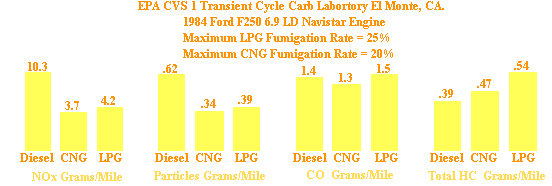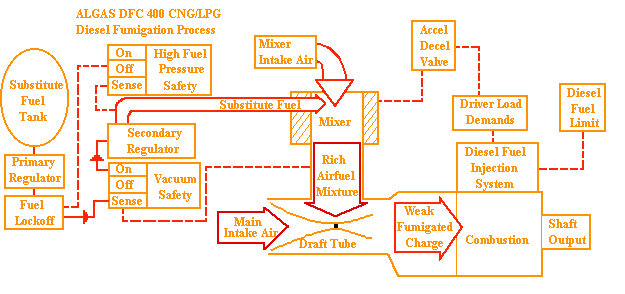DIESEL ENGINE FUMIGATION
- GOALS:
- To become aware of the Clean Air Act of 1990 and its impact on diesel engine operation.
- OBJECTIVES:
- The student will be able to:
- 1. Describe the fumigation process.
- 2. Understand how the engine fumigation process can reduce exhaust emissions.
- LESSON / INFORMATION:
- The Problem.
- The Clean Air Act of 1990 addresses the pollution problem of exhaust smoke and particulate materials. It also addresses the requirements for reduced HC, CO, and NOx emissions for all on-road vehicles. Until the passage of the 1990 law, smoke and particulates were not regulated. Prior Clean Air Acts made on-road vehicles in excess of 26,000 pounds GVW virtually exempt from the emissions control program.
- Generally, diesel engines produce high levels of NOx emissions and significant smoke and particulate material levels. Generated smoke may be classified as "Hot Smoke" or "Cold Smoke". Hot Smoke results from incomplete combustion during heavy engine loads. Hot smoke also results from an over-rich fuel mixture. Insufficient oxygen prevents the diesel fuel from completely oxidizing. Besides generating particulate pollution, hot smoke performs no useful work; it reduces net engine power and lowers vehicle mpg. Traditional engine adjustments do nothing to hot smoke production. Fumigation reduces most hot smoke production resulting in reduced pollution and increased vehicle mpg.
- Smoke produced during light engine loads is called "cold smoke". Traditional engine adjustments (engine timing and advance), leaking injectors, and poor quality diesel fuel are the contributors to cold smoke. Cold smoke produces the same emission pollutant particulate matter. Fumigation does not abate cold smoke.
- Mandated reductions have forced manufacturers to reexamine the diesel engine combustion process to discover answers. For four-stroke diesel engines, fumigation is a relatively low cost and easily adaptable solution.
- What is Fumigation?
- A fumigation system injects a gaseous or liquid fuel into the intake air stream of a compression ignited engine. This fuel burns and becomes a part-contributor to the power producing fuel. While alcohol and gasoline may be used, gaseous fumigation seems to exhibit the best overall power yields, performance, and emissions benefits. LPG (Liquified Petroleum Gas) or CNG (Compressed Natural Gas) is used. The fumigation process is divided into major fraction and minor fraction fumigation. When more than 50% gaseous injection is used, it is known as major fraction fumigation. Minor fraction fumigation is under 50% gaseous injection. One after-market fumigation component supplier, Algas Corporation, using 20 to 25% fumigation rate, reports excellent performance benefits and reduced target emissions. One test for a 1984 6.9 liter diesel engine in an F250 chassis showed a 64% reduction in NOx and 45.2% reduction of particulates. CO was almost unchanged. However, total emissions of hydrocarbons in grams per mile increased (see graph below).

- Graph courtesy of Algas Corporation, a Division of Precision General Inc.
- History of Fumigation
- Rudolph Diesel's 1901 patent mentions the diesel fumigation process. Not until the 1940's were there any commercial fumigation applications. Cooper-Bessemer introduced large, big-bore, stationary engines which ran on 95% natural gas and 5% diesel. Since then other manufacturers have used fumigation to boost power output. Fumigation has been successfully used in agricultural machines for many years. To date, Texas and Colorado have accepted fumigation as an alternative fuel.
- Benefits
- For nonstationary variable RPM engines, variable ratio fumigation is more effective than fixed rate fumigation. As a result, engine load and fumigation rates are matched. Reduced NOx and particulate emissions are the most outstanding benefits. Minor fraction fumigation yields significant (up to 25%) gains in smoke-limited torque gains. There are other technical non-pollution related gains. Tests show reduced exhaust temperature, reduced crankcase solids, reduced injection service and longer acceptable crankcase drains. Diesel exhaust odor is also reduced.
- How Does It Work?
- The major engine modifications include:
- -- addition of a venturi-draft tube in the air intake system
- -- secondary fuel tank, safety controls, and switches
- -- acceleration-deceleration control valve
- -- microcomputer control. (See Figure 1 below)

- Figure 1.Courtesy of Algas Corporation, a Division of Precision General Inc.
- The venturi-draft physically introduces and mixes LPG or CNG with the air charge. Since diesel engines operate with near zero manifold vacuum, an air-venturi draft tube is necessary to create a signal proportionate to engine speed. During installation the baffles and the tube are calibrated for fumigation onset and maximum fumigation rate. The fuel mixer is added to the draft tube. This provides the point of introduction for the gaseous fuel. Mixer calibration is based on the maximum fumigation rate. Fuel regulators differ for CNG and LPG fumigation systems. Since CNG tank pressure may reach up to 3,600 psi a primary regulator is necessary. LPG fumigation systems do not require this component since tank pressures are less than 300 psi. A secondary regulator allows the LPG or CNG to expand to a gaseous state. This regulator provides a safety factor and locks out fuel flow in the event of a system failure.
- The acceleration-deceleration control precisely times the fumigator fuel. If fumigation occurs prematurely on acceleration or is late in turning off on deceleration, fuel is wasted. Late fumigation on acceleration produces a lean, poorly combusted power cycle. Drivers notice a power lag on acceleration. This control instantly senses a change in engine load and responds by properly adjusting the fumigation rate for the required diesel-delivery rate. The control output signal results in the opening or closing of the mixer control valve. This valve controls the fumigation fuel flow rate.
- Properly sized LPG/CNG fuel tanks are necessary to provide fumigation for the quantity of diesel carried. These tanks must meet state and federal safety requirements. In some locations, installation position (i.e., inside the frame) is also regulated. The Diesel Fuel Limit Switch prevents excess fuel delivery when the fumigation system is active. This switch prevents over fueling which wastes fuel and produces exhaust smoke. This switch allows 100% of diesel flow in the event that fumigation fuel ceases to flow.
- The microcomputer controls the functions of each of these devices. It performs the logic function to ensure that the system operates within design parameters. It also can sense malfunctions allowing the engine to default into a standard diesel, nonfumigated engine.
- ACTIVITY 1:
- Divide the class into groups. Assign several questions to each group. Each group finds the answers and presents them to the class.
- Discussion questions:
- 1. What problem does the Clean Air Act of 1990 address concerning diesel engines?
- 2. What is a simple definition of fumigation?
- 3. What kind of fumigation seems to exhibit the best overall power yields, performance, and emission benefits?
- 4. What are major and minor fraction fumigation?
- 5. What are the four (4) major modifications (show on diagram)?
- 6. What does the venturi-draft do and why is an air venturi-draft tube so necessary?
- 7. Why is a primary regulator needed on a CNG fumigation system and not on a LPG fumigation system?
- 8. What purpose does a secondary regulator have?
- 9. What precisely times the fumigation fuel and how does it work?
- 10. What is the importance of a diesel Fuel Limit Switch?
- 11. What does the microcomputer do and why is it important?
- 12. What are the benefits of a diesel fumigation process?
- ACTIVITY 2:
- Call, write, or visit a local LPG distributor and/or a local CNG vehicle fuel distributor. Seek an interview with a manager or supervisor who is familiar with local diesel trucking operators and agricultural customers. Using the interview guide sheet below determine:
- 1. The number of fleet units or tractors using fumigation.
- _________________________________________________________________
- 2. The availability of fumigation conversion kits.
- _________________________________________________________________
- 3. The availability of technically competent personnel to install a fumigation kit.
- _________________________________________________________________
- 4. The number of conversions completed at this location.
- _________________________________________________________________
- 5 .Success and problems associated with any fumigated engines at this service location.
- _________________________________________________________________
- Write a short paragraph summarizing your findings.
- INFORMATION CHECK:
- Indicate whether the statements below are True or False. If the statement is false, explain why it is false.
- _____1. A fumigation system injects a gas or liquid into the intake air stream of a compression ignited engine.
- _____2. The Clean Air Act of 1990 concerns only diesel engines.
- _____3. When using a properly installed fumigation system, fewer pollutants of all kinds are reduced.
- _____4. The Diesel Fuel Limit Switch mixes LPG or CNG with diesel fuels.
- _____5. Microcomputers manage injection of the gas or liquid additions.
- _____6. A positive side benefit of using a fumigation system is that diesel exhaust odor is reduced.
- TEACHER'S NOTES:
- ANSWERS TO ACTIVITY 1 (Discussion Questions):
- 1. The Clean Air Act of 1990 addresses the pollution problem of exhaust smoke, particulate materials, as well as the requirements for reduced HC, CO, and NOx emissions for all on-road vehicles.
- 2. Fumigation is a system that injects a gaseous or liquid fuel into the intake air stream of a compression ignited engine.
- 3. Gaseous fumigation seems to exhibit the best overall power yields, performance and emission benefits.
- 4. Major fraction fumigation is when more than 50% gaseous injection is used. Minor fumigation is when less than 50% gaseous injection is used.
- 5. The four major engine modifications are:
- - addition of a venturi-draft tube in the air intake system
- - secondary fuel tank, safety controls, and switches
- - acceleration-deceleration control valve
- - microcomputer control.
- 6. Venturi-draft physically introduces and mixes LPG or CNG with the air on intake. An air venturi-draft tube is necessary to create a signal proportionate to engine speed.
- 7. A primary regulator is needed because CNG tank pressure may reach 3,600 psi but the regulator is not needed for LPG fumigation systems because the tank pressures are less than 300 psi.
- 8. The secondary regulator allows the liquid LPG or CNG to expand to a gaseous state. The regulator provides a safety factor and locks out fuel flow in the event of a system failure.
- 9. The acceleration-deceleration control precisely times the fumigation fuel. If fumigation occurs prematurely on acceleration or it is late in turning off on deceleration, fuel is wasted. Late fumigation on acceleration produces a lean poorly combusted power cycle.
- 10. The Diesel Fuel Limit Switch prevents excess fuel delivery when the fumigation system is active. This switch prevents over fueling which wastes fuel and produces exhaust smoke. It also allows 100% of diesel flow in the event that fumigation fuel ceases to flow.
- 11. The microcomputer controls the functions of each device. It performs the logic function to ensure that the system operates within design parameters, and it can sense malfunctions, thus allowing the engine to default into a standard diesel nonfumigated engine.
- 12. The benefits are: reduced NOx and particulate emissions; minor fraction fumigation yields, significant gains in smoke-limited torque gains; reduced exhaust temperatures; reduced crankcase solids; reduced injection service; longer acceptable crankcase drains; and reduced exhaust odor.
- ANSWERS TO ACTIVITY 2 (True / False):
- 1. True
- 2 .False. The 1990 Act includes all engines.
- 3. False. Fumigation controls mostly smoke particulates and NOx.
- 4. False. Fumigation fuels are mixed with air. Diesel is injected into the combustion chamber.
- 5. True.
- 6. True.
- REFERENCES:
- Algas Carburetion DFC 400 Diesel Fumigation Systems, Algas Corporation, 1991.
- McCray, James. Fumigation of Diesel Engines with Gaseous Fuels: A Practical Solution to Urban Air Pollution. Unpublished report by Power Research.
Comments or questions to: TechAsmt@LA.GOV
Return to Diesel Menu



